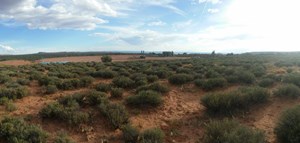USGS: Vegetation recovery on abandoned oil and gas well sites is variable
RESTON, Virginia -- Recovery of vegetation on plugged and abandoned oil and gas well sites on the Colorado Plateau is influenced by time, moisture, nonnative plants and the type of plant community that was originally in place before well sites were constructed, according to a recently published study by the U.S. Geological Survey.
“The Colorado Plateau is an ecologically diverse region used for energy development, agriculture and recreation, including approximately 30 national parks,” said USGS scientist and author of the study Miguel Villarreal. “Understanding the factors that encourage successful re-vegetation is critical for resource managers to make informed decisions about this region of economic and ecological importance.”
There are more than 26,000 abandoned and 63,000 active gas and oil wells on the Colorado Plateau. When these wells are plugged and abandoned, re-vegetation is necessary to limit soil erosion, recover forage for livestock and provide wildlife habitat. Most of the Colorado Plateau is made up of moisture-limited ecosystems, making vegetation recovery efforts difficult.
USGS scientists used satellite, soil and climate data to study three to six years of re-vegetation at 365 well sites in parts of Utah, Colorado and New Mexico that were drilled in 1985 or later and abandoned in 1997 or later. A top-down view of the amount of the soil surface covered by plants, called vegetation cover, on abandoned well sites was compared to vegetation cover on nearby reference sites that did not contain wells to determine the relative recovery of vegetation. This study used a scientific approach that was developed last year by USGS scientists.
There was a wide range of re-vegetation among the sites. After five years of recovery, vegetation cover on well sites was 36% of that found on reference sites, on average. About half of the well sites in the study contained less than 26% vegetation cover found on reference sites. About one third of the well sites had more than 50% of the vegetation cover found on reference sites. The USGS has initiated a number of studies to better understand what restoration techniques are working, which are not, and where.
Some of the variation in re-vegetation among abandoned well sites might be due to differences in moisture from year to year. Relatively wet years, like 2005, 2008 and 2011, were associated with relatively high vegetation recovery. The driest year in the study, 2002, was associated with low vegetation values.
The type of plant community in which abandoned well sites were located was also important. Vegetation recovery was generally lower on abandoned well sites in shrublands and pinyon pine-juniper woodlands, with re-vegetation in these systems being about half that of well sites in grasslands.
Results also show that some nonnative species like cheatgrass and Russian thistle can become established in abandoned well sites. Although these species contribute to vegetation cover, they are not as desirable as native species.
The Colorado Plateau is approximately 131,000 mi2 in size and is located in parts of Arizona, Utah, Colorado and New Mexico. The plateau is an ecologically diverse region containing grasslands, shrublands, woodlands and forests.
“Landsat imagery and other observational data can be instrumental in identifying sites at risk of poor recovery and help inform strategies to improve successful reclamation following oil and gas development in the Colorado Plateau,” said Villarreal.




